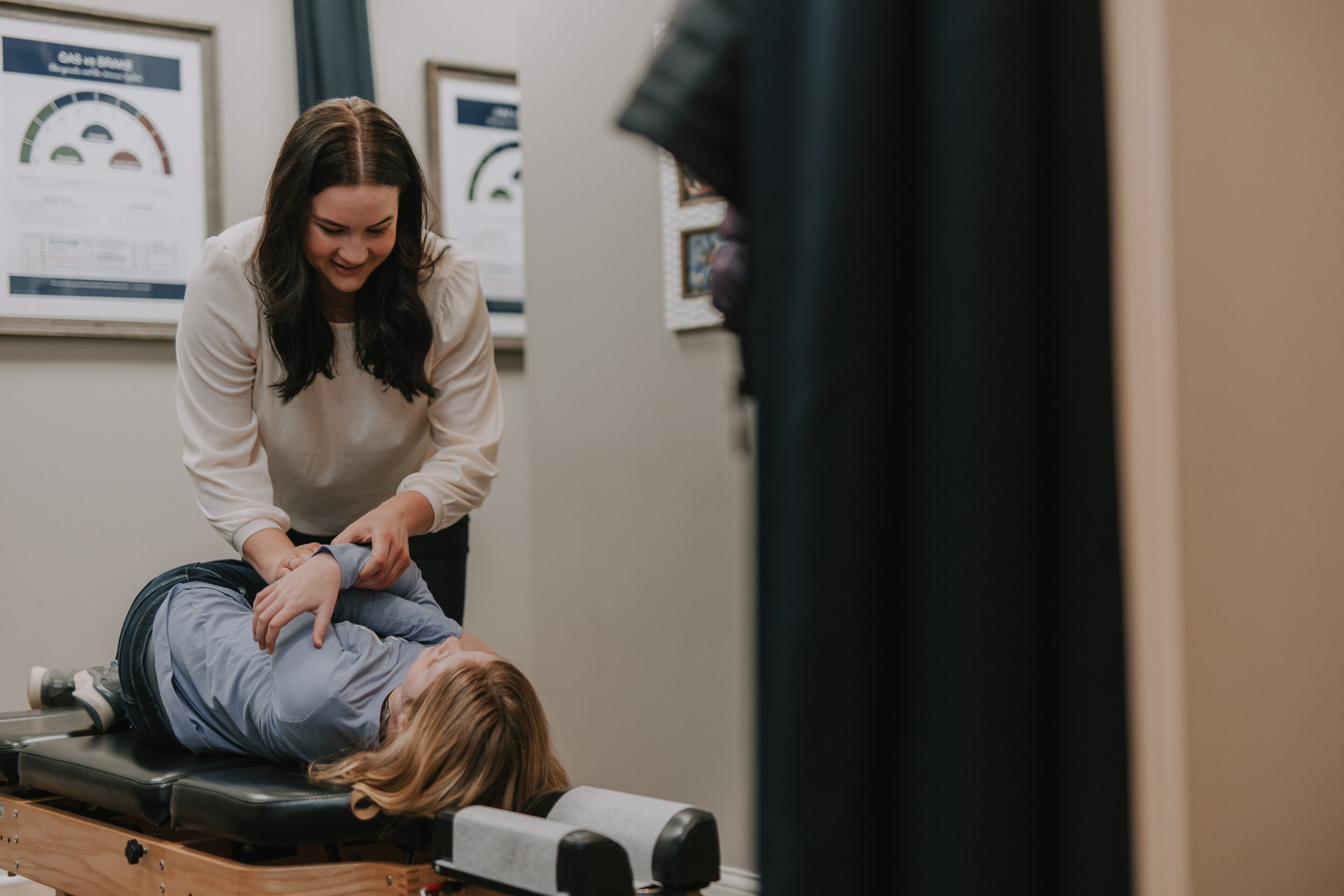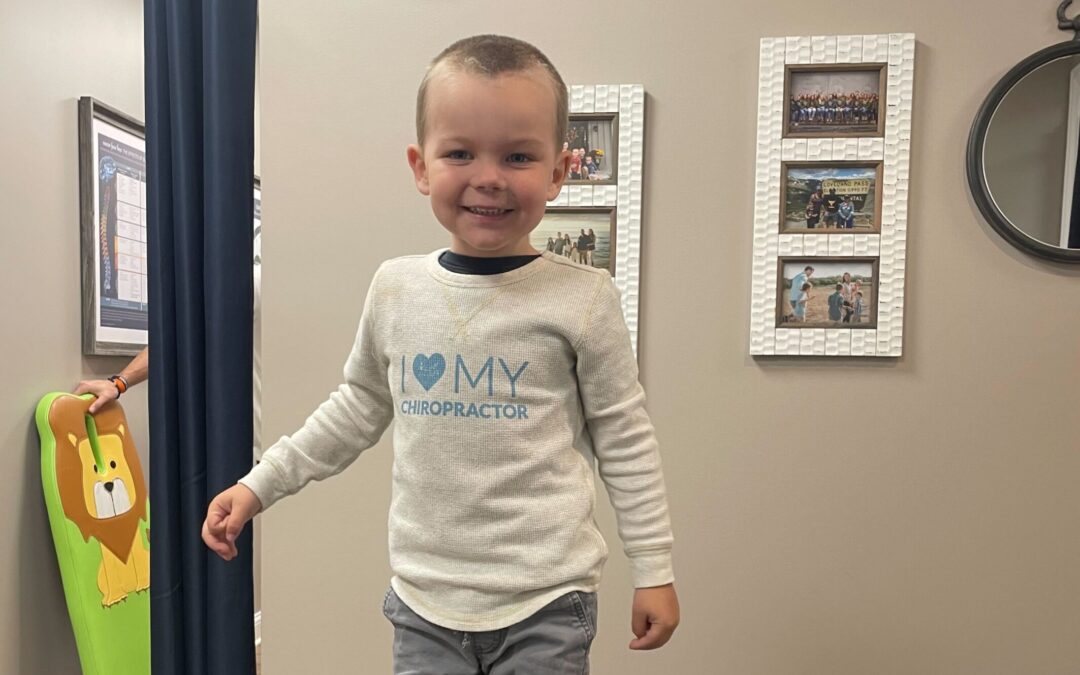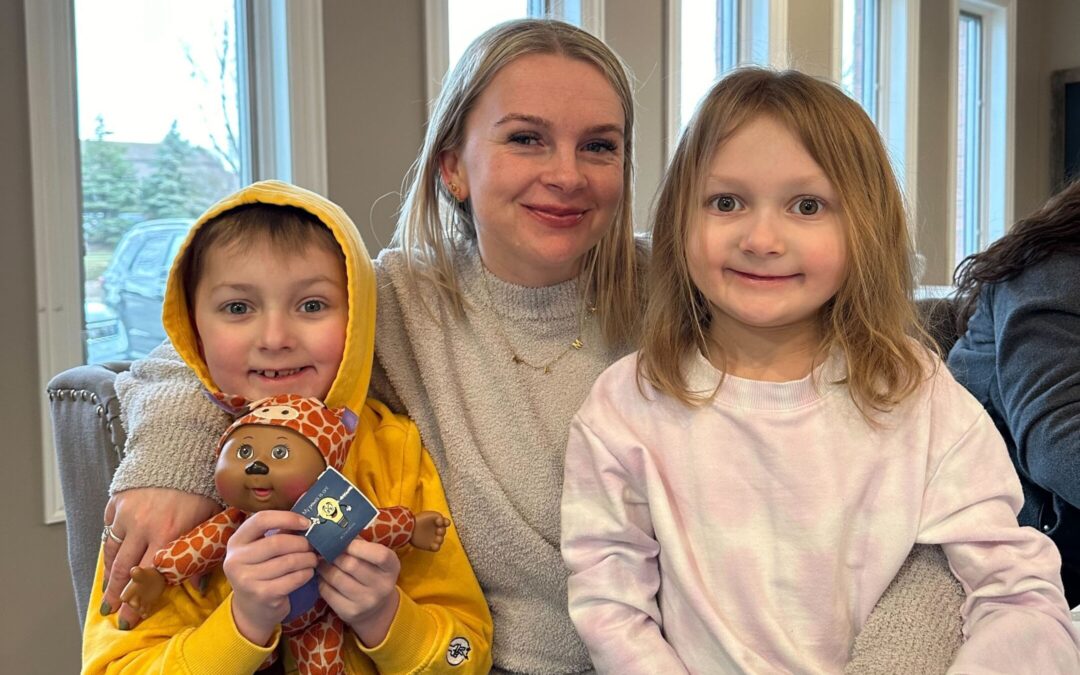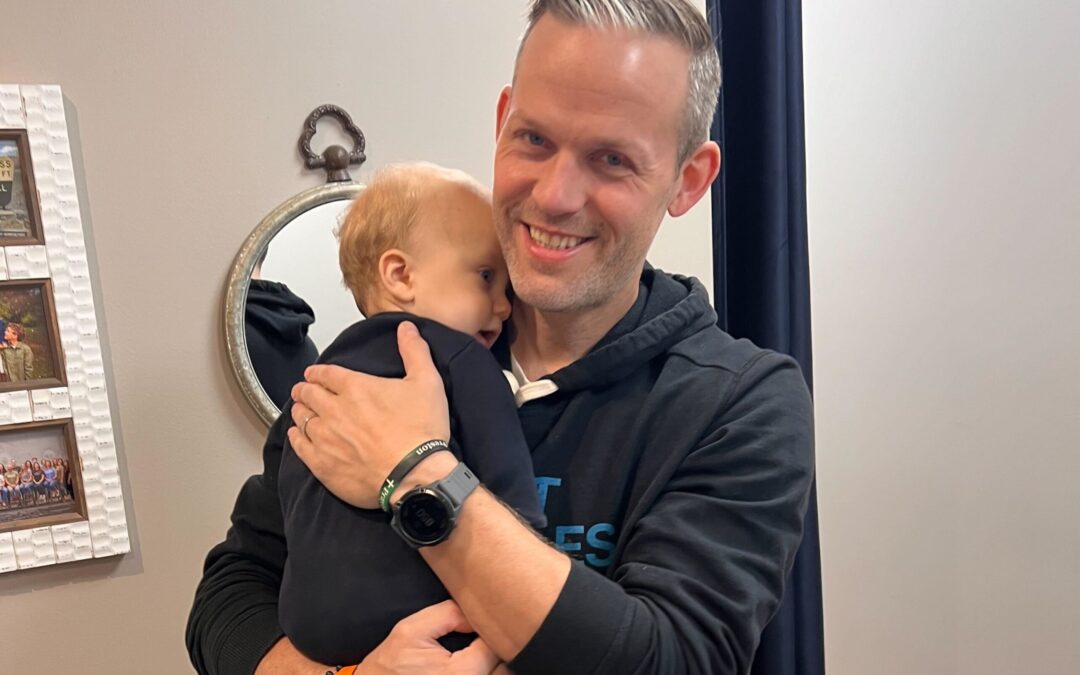Imagine a world without knowing where your body is in space, constantly struggling to maintain your balance and coordination, and having difficulty with even basic everyday tasks like putting on clothes and brushing your teeth. These are the challenges faced by children with proprioception disorders.
What makes matters worse is that over time, these difficulties with muscle movements and bodily coordination eventually alter the way the brain and nervous system develop and function for that child and can be a leading cause of things like Sensory Processing Disorder and Autism Spectrum Disorder later on in life. In fact, challenges with proprioception and coordination can even lead to ADHD-related problems later in life as well.
This was the case with Joseph. He was struggling with anxiety, autism spectrum disorder, poor posture, ataxia, and low muscle tone. It was heartbreaking for his family to watch him lose all confidence in his own abilities. This all stemmed from his challenges with proprioception.
This super basic and simple function is absolutely crucial to overall brain and neurological development for kids, so any and all challenges with proprioception must be taken very seriously by both parents and professionals. In order to do just that, we need to understand that the root cause of proprioception challenges goes way beyond what’s happening in the muscles and really starts within the nervous system itself.
In this article, we will explore the fascinating concept of proprioception, its importance in our children’s daily lives and development, and how it can be measured and improved upon if your child struggles with proprioception and its related conditions.
What is Proprioception?
Proprioception, also known as kinesthesia, can be described as our “sixth sense.” It is the internal awareness of our body’s position, movement, and spatial orientation. While we may not consciously think about it, proprioception is essential for everyday tasks such as walking, writing, or even reaching for an object.
For the developing child, proprioception is absolutely essential. Both gross and fine motor development are critical early developmental milestones that a child must make their way through before higher brain development and cognitive developments like memory, behavioral, and emotional regulation can develop and be learned.
Put simply, if the brain struggles to know where it is in physical space, it’s going to also struggle with things like focus, concentration, and emotional regulation. We’ll break this down much more throughout the article, including the good news of how much we can improve brain development and function by focusing first on improving proprioception!
How Proprioception Works
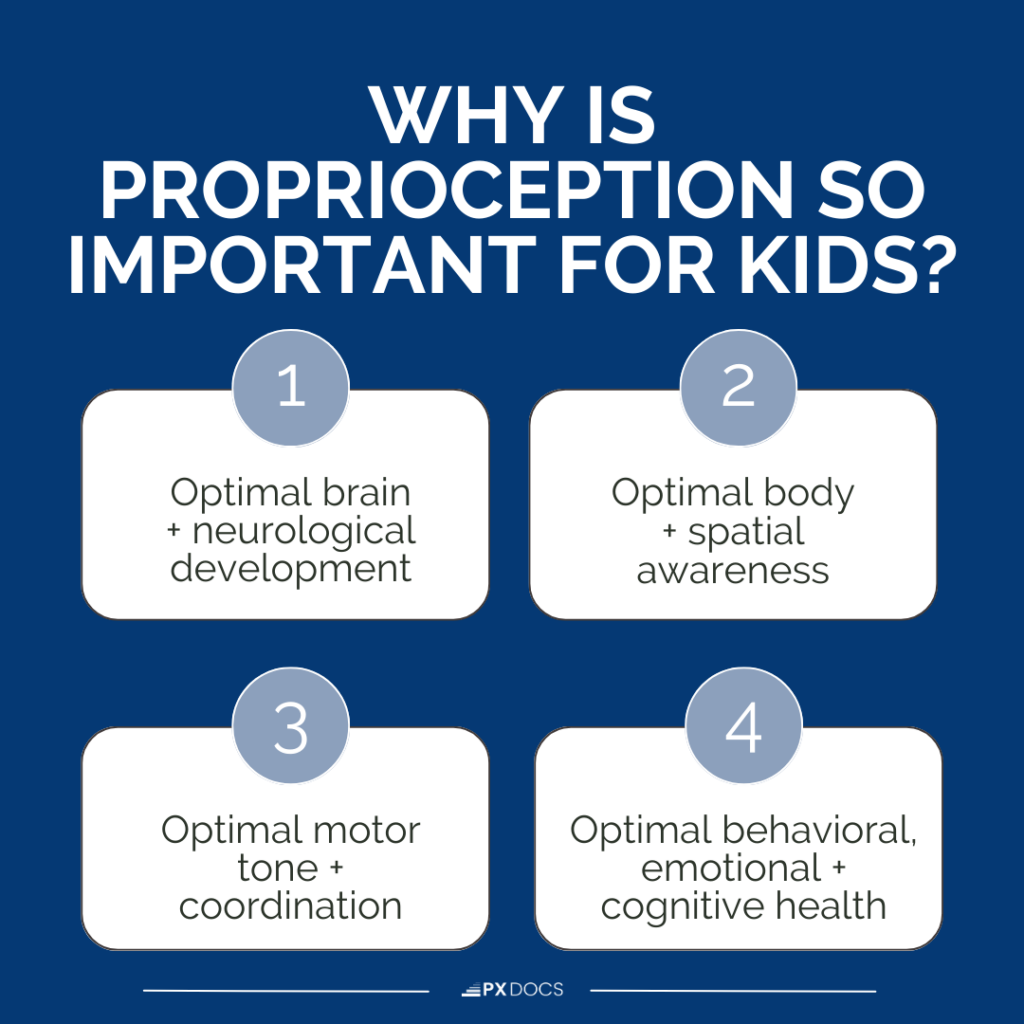
Proprioception relies on a network of sensory receptors that are scattered throughout our body, and most densely populated within the brainstem, neck, and neurospinal regions. From there, a child’s hands, feet, and mouth are also densely packed with sensory receptors that convey proprioceptive information back to the brain.
These receptors provide information to our brain about the position, speed, and direction of our movements. Knowing where the body is in space at all times is a crucial part of the brain’s primary function, and when movement coordination and balance are functioning well, it keeps the brain calm, organized, and efficient.
The three primary types of receptors involved in proprioception are:
- Muscle Spindles: Muscle spindles are located within our muscles and detect changes in muscle length and stretch. When a muscle stretches, the muscle spindle sends signals to the brain, allowing us to perceive the position and movement of our limbs.
- Golgi Tendon Organs: Golgi tendon organs are found within our tendons, near the junctions where muscles attach to bones. They provide information about muscle tension and force. When we exert force on an object, these receptors help us gauge the amount of force being applied.
- Joint Receptors: Joint receptors are located within the capsules and ligaments surrounding our joints. They provide feedback on joint position and movement. These receptors contribute to our sense of joint stability and help us maintain balance during various activities.
Additionally, it’s important to know that two areas near the base of the brain, the cerebellum and brainstem, are heavily involved in coordinating proprioception inputs and outputs. This is why things like birth trauma, torticollis, and plagiocephaly serve as such strong early warning signals of problems with position sense and proprioception later on in life and thus are strongly correlated with conditions such as Autism, Sensory Processing Disorder, and ADHD.
Proprioception Disorder
Proprioception disorders can significantly impact an individual’s ability to navigate the world smoothly. Common symptoms of proprioception disorders include:
- Unbalanced Movements: People with proprioception disorders may experience frequent loss of balance, especially on uneven surfaces or when sudden changes in direction occur.
- Inappropriate Force Control: Difficulty determining how much strength to use for a particular task is another common characteristic. Individuals may either exert too little or too much force, leading to challenges in everyday activities. Challenges here lead a child to be sensory “seeking” or, for others, to “avoid” certain sensory stimuli.
- Uncoordinated Movement: Proprioception disorders can result in uncoordinated movements, making tasks requiring precise control, such as handwriting or playing instruments, more challenging.
But as mentioned above, the problems do not stop there. Other common pediatric neurosensory conditions linked to problems with proprioception include:
- Autism Spectrum Disorder (ASD): Children with ASD may have challenges with body awareness, coordination, and motor skills, which can be attributed to disruptions in proprioceptive processing. These difficulties can affect their ability to engage in coordinated movements, regulate body movements, and perform fine motor tasks, which then leads to difficulties with behavioral, emotional, and social regulation.
- Attention Deficit Hyperactivity Disorder (ADHD): Because the brain’s most primary and basic function is to know where the body is in space at all times, coordinating hundreds of muscles and joints all at once, when it struggles with that core function, it also then becomes “distracted” from other important functions such as focus, concentration, memory, impulse control, and behavior.
- Sensory Processing Disorder (SPD): Out of all the sensory elements the brain and body have, proprioception is the most influential to not just physical regulation and coordination but emotional and behavioral regulation as well.
Causes of Proprioception Disorders
Proprioception disorders can arise from various underlying causes. Some potential factors contributing to these disorders include:
- Traumatic Brain Injuries (TBI): Traumatic brain injuries can disrupt the brain’s ability to process sensory information accurately, affecting proprioception.
- Birth Trauma: The increased rate of birth interventions in the last generation or two of children has led to an increase in the amount of birth trauma children experience to the crucial brainstem and cerebellum regions heavily involved in proprioception.
- Joint Injuries: Injuries to joints, such as sprains or dislocations, can damage the joint receptors and affect proprioceptive feedback. A developing toddler and child frequently experience falls and physical “micro” traumas that may stack up and lead to proprioceptive challenges.
- Excessive Toxic Load or Emotional Trauma: All forms of stress affect the brain and body similarly, meaning that if a child is exposed to high amounts of toxins or emotional stressors early in life, it could shift their nervous system into a state of sustained sympathetic fight or flight tone, a condition known as dysautonomia.
The Role of Subluxation Plays in Proprioception Disorders
In addition to dysautonomia, the other term parents whose children struggle with proprioception, position sense, and any of these related conditions need to know about is something called subluxation.
Subluxation directly alters and distorts proprioceptive function in a major way due to joint misalignment, fixation, and decreased range of motion. It’s the latter part of the subluxation equation that causes all the trouble, distorting and disrupting proprioceptive input into the brainstem and cerebellum, leaving the brain and body confused and disconnected.
The worst place for a child to have subluxation is the upper cervical (neck) and brainstem region since it’s the area directly responsible for controlling and coordinating all the nerves and muscles responsible for proprioception, gross motor function, and fine motor control as well. This is why things like birth intervention (forceps, vacuum, induction, and c-section), birth trauma, torticollis, and plagiocephaly are so strongly associated with proprioceptive related conditions such as ASD, SPD, and ADHD.
Proprioception Care Options
Fortunately for parents, there are various ways to address and improve proprioception for your child and help get their muscles, nerves, and brain functioning and working together once again!
The first option most parents learn about for proprioceptive and sensory integration disorders is physical and occupational therapy. These are wonderful options that work with the muscles of the body to regain strength, improve balance, and develop strategies to manage their symptoms effectively.
However, many parents report to us that while they see some improvements with PT and OT, often their child will reach a plateau or have significant proprioceptive and sensory challenges remain, despite the hard work they put in with therapy. In these cases, it’s almost certainly subluxation and neurological dysfunction still at play, revealing a deeper root cause that goes beyond just the muscles.
As Neurologically-Focused Pediatric Chiropractors, the entire goal of our care is to address the root cause by working with the nervous system first and foremost. The tone and coordination of the nervous system is what first determines the tone and coordination of the muscles and joints of the body, so by working directly with the nervous system first our Neuro-Tonal adjusting techniques can have a profound effect on proprioception and related challenges in kids.
Each and every adjustment is designed to address the subluxation and neurological imbalance head on, seeking to restore built up and stuck tension in certain joints, and then restore balance and coordination to others.
That’s what happened when Joseph (mentioned at the start of the article) began getting care with our Neuro Intensive Program. Within just a matter of a few days and half a dozen Neuro-Tonal Adjustments, his proprioception, body sense and awareness, and self-confidence improved so much that he told his mom he wanted to go to the gym and workout! From sitting and being slouched over all day for years on end to hitting the treadmill and lifting weights within one week – that’s the impact Neurologically-Focused Chiropractic can make!
If your child is struggling with proprioceptive disorders, it’s important to take them to an appropriately trained Pediatric Chiropractor, ensuring they use the right technology and techniques to address their challenges in full. You’ll find an entire directory of trained and ready Neurologically-Focused Pediatric Chiropractors here on our site, and you can learn more about the incredible technology we use to assess proprioception and sensory processing disorder at the links below:
- The PX Docs Clinical Process: Our trained PX Docs begin with an in-depth consultation for each and every patient and will explain things in detail and walk parents through each step of the process in an easy-to-understand manner.
- The INSiGHT Neurological Scans: This incredible piece of technology helps us find and measure subluxation and dysfunction within the nervous system, muscles, and neurosensory system directly, making it absolutely invaluable and a must have for any professional working with proprioceptive disorders in children.
Parents, you’ve probably heard the phrase “movement is life” before, and it’s absolutely true. Well, for your developing child, it’s truly everything. Therefore proprioception is everything for the health and development of your child, and getting it back on track is the first step to helping them improve not just their body’s tone and coordination but things like emotional and behavioral regulation as well!
Get connected with your local PX Doctor by visiting our directory right away, and for even more support with daily sensory struggles, download our free guide for smoothing sensory transitions here!

